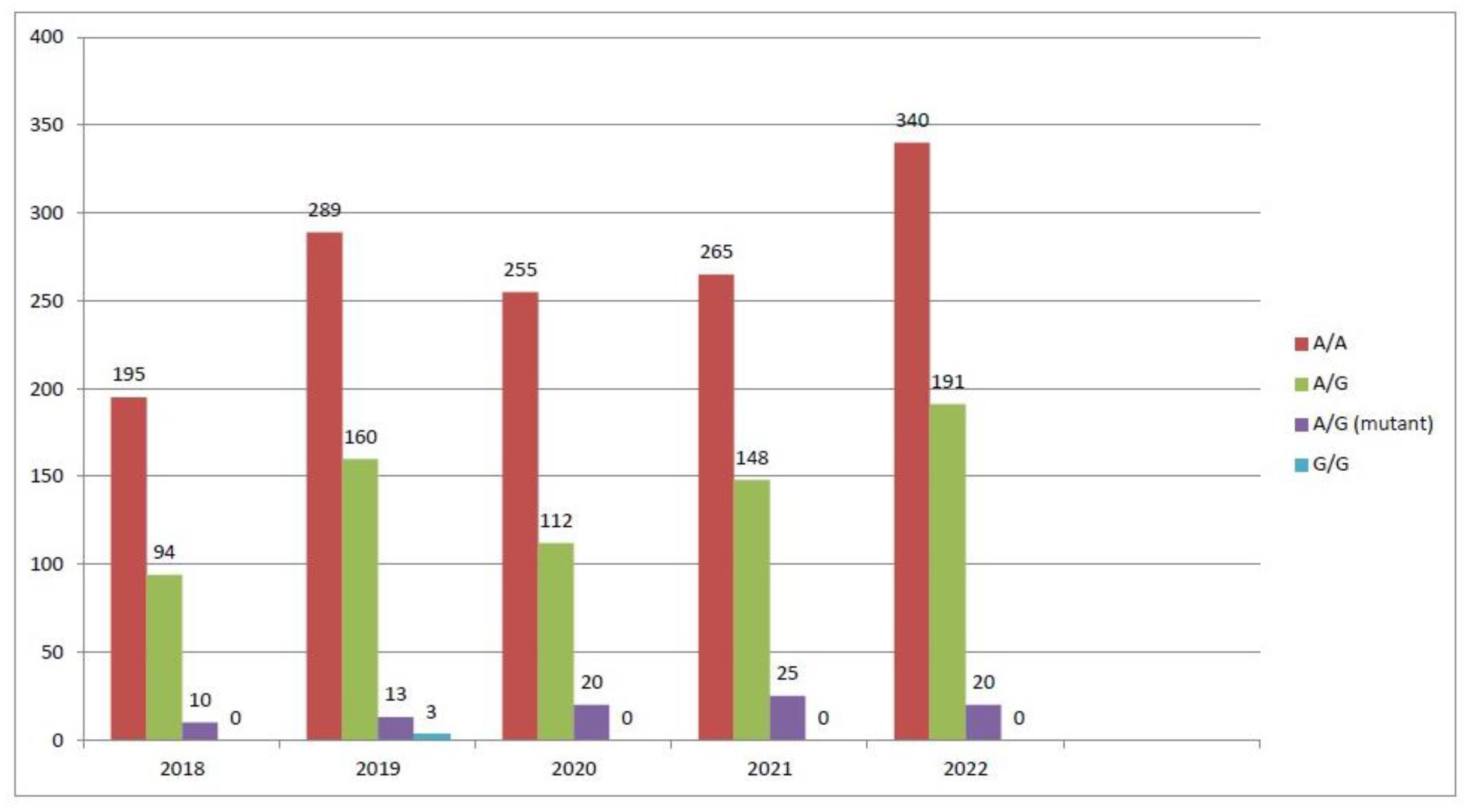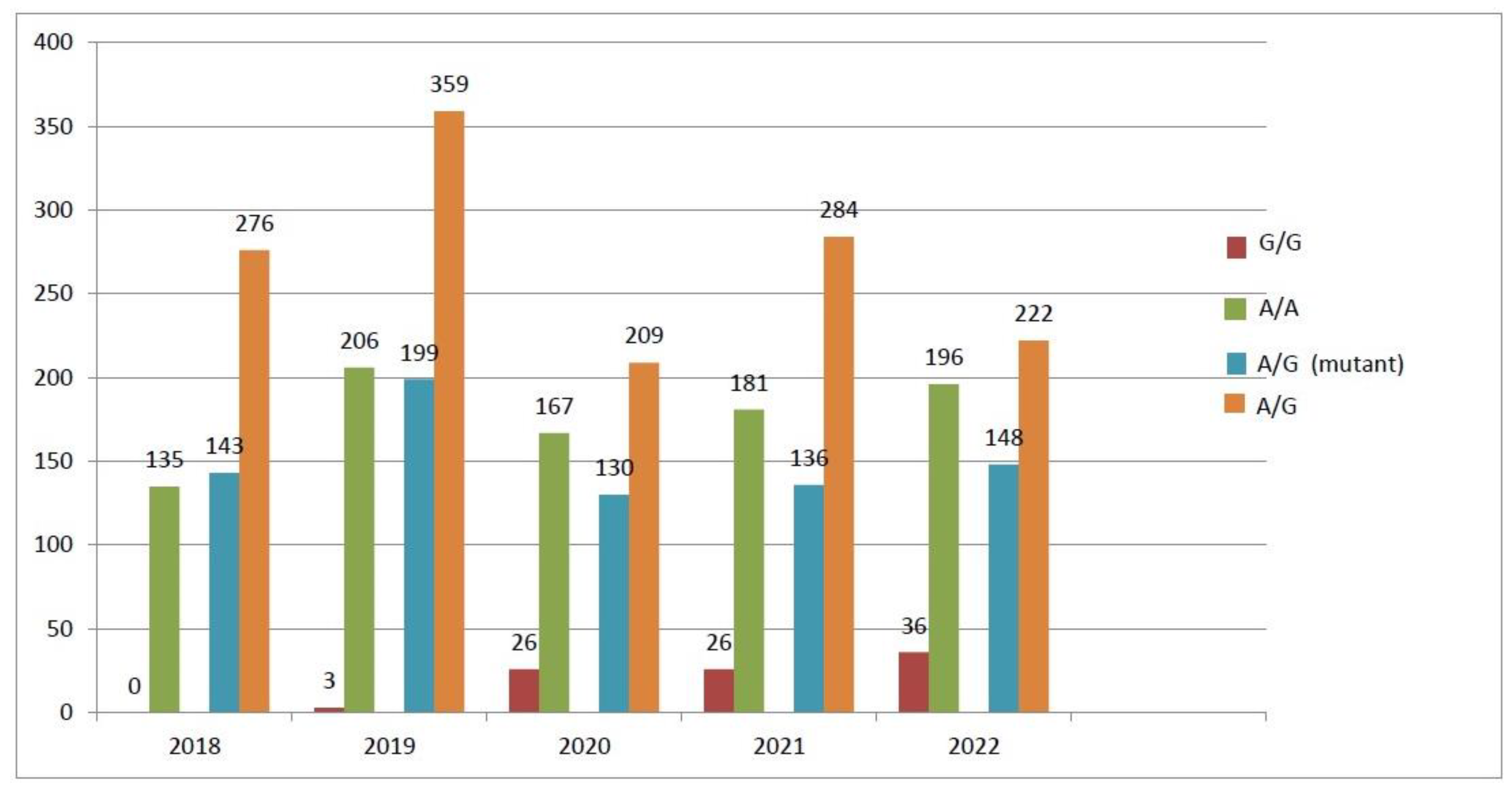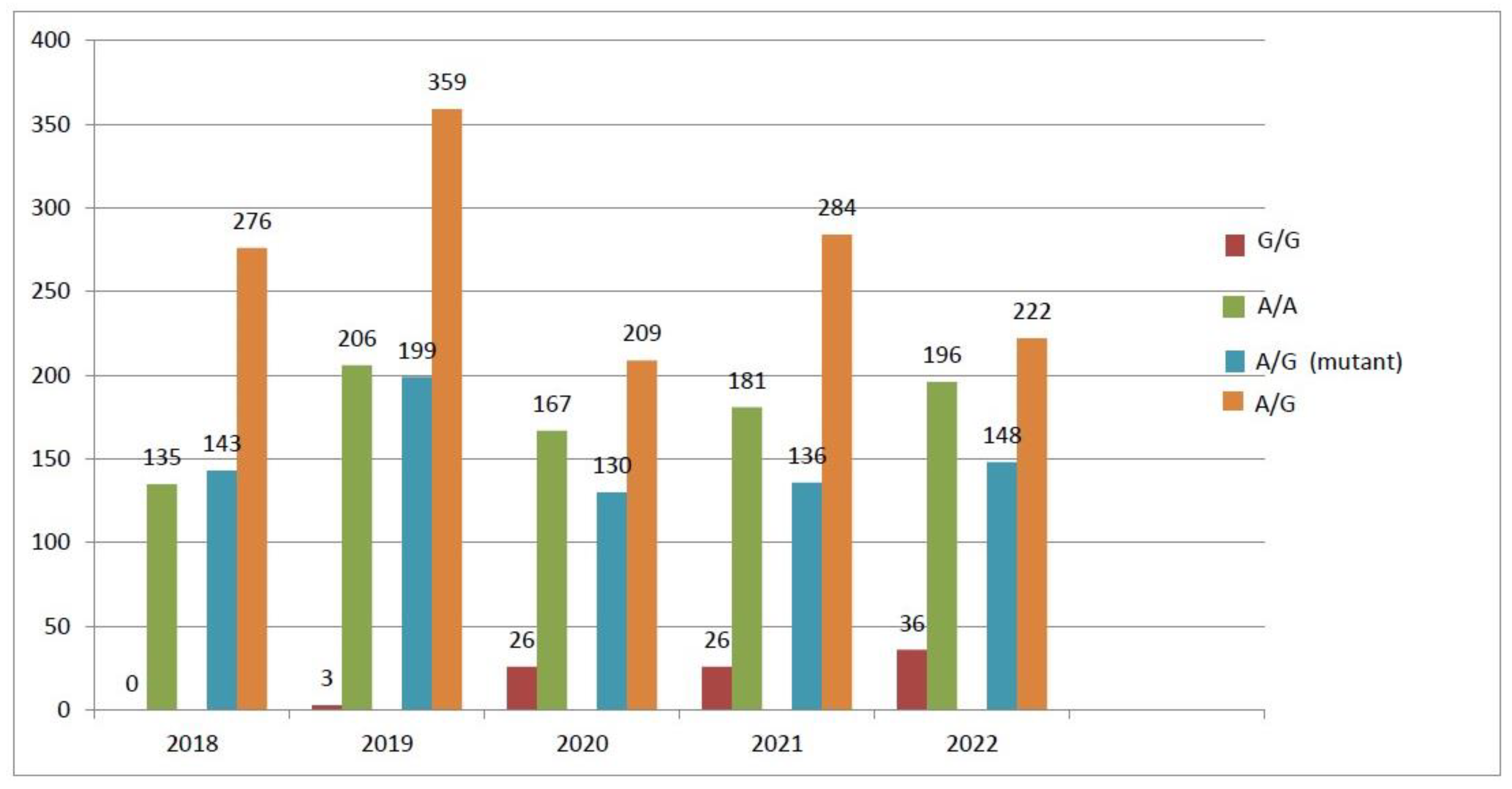Polymorphism of Folate Metabolism Genes among Ethnic Kazakh Women with Preeclampsia in Kazakhstan: A Descriptive Study
Abstract
:Simple Summary
Abstract
1. Introduction
2. Materials and Methods
2.1. Study Design and Study Subjects
2.2. Ethical Considerations
2.3. Laboratory Setting
2.4. Genes
2.5. Blood Collection and Genomic DNA Isolation
2.6. Statistical Analysis
3. Results
4. Discussion
Study Strengths and Limitations
5. Conclusions
Author Contributions
Funding
Institutional Review Board Statement
Informed Consent Statement
Data Availability Statement
Acknowledgments
Conflicts of Interest
References
- ACOG. Gestational Hypertension and Preeclampsia. Obstet. Gynecol. 2020, 135, 1492–1495. [Google Scholar] [CrossRef] [PubMed]
- Croke, L. Gestational Hypertension and Preeclampsia: A Practice Bulletin from ACOG. Am. Fam. Physician 2019, 100, 649–650. [Google Scholar] [PubMed]
- Rana, S.; Lemoine, E.; Granger, J.P.; Karumanchi, S.A. Preeclampsia: Pathophysiology, challenges, and perspectives. Circ. Res. 2019, 124, 1094–1112. [Google Scholar] [CrossRef]
- Ives, C.W.; Sinkey, R.; Rajapreyar, I.; Tita, A.T.N.; Oparil, S. Preeclampsia—Pathophysiology and Clinical Presentations. J. Am. Coll. Cardiol. 2020, 76, 1690–1702. [Google Scholar] [CrossRef]
- Kaldygulova, L.; Ukybassova, T.; Aimagambetova, G.; Gaiday, A.; Tussupkaliyev, A. Biological Role of Folic Acid in Pregnancy and Possible Therapeutic Application for the Prevention of Preeclampsia. Biomedicines 2023, 11, 272. [Google Scholar] [CrossRef]
- Say, L.; Chou, D.; Gemmill, A.; Tunçalp, Ö.; Moller, A.B.; Daniels, J.; Gsülmezoglu, A.M.; Temmerman, M.; Alkema, L. Global causes of maternal death: A WHO systematic analysis. Lancet Glob. Health 2014, 2, e323–e333. [Google Scholar] [CrossRef] [PubMed]
- Geller, S.E.; Koch, A.R.; Garland, C.E.; MacDonald, E.J.; Storey, F.; Lawton, B. A global view of severe maternal morbidity: Moving beyond maternal mortality. Reprod. Health 2018, 15 (Suppl. 1), 98. [Google Scholar] [CrossRef]
- Johnson, J.D.; Louis, J.M. Does race or ethnicity play a role in the origin, pathophysiology, and outcomes of preeclampsia? An expert review of the literature. Am. J. Obstet. Gynecol. 2020, 226, S876–S885. [Google Scholar] [CrossRef]
- Phipps, E.; Prasanna, D.; Brima, W.; Jim, B. Preeclampsia: Updates in Pathogenesis, Definitions, and Guidelines. Clin. J. Am. Soc. Nephrol. 2016, 11, 1102–1113. [Google Scholar] [CrossRef]
- Jeddi-Tehrani, M.; Torabi, R.; Zarnani, A.H.; Mohammadzadeh, A.; Arefi, S.; Zeraati, H.; Akhondi, M.M.; Chamani-Tabriz, L.; Idali, F.; Emami, S.; et al. Analysis of plasminogen activator inhibitor-1, integrin beta3, beta fibrinogen, and methylenetetrahydrofolate reductase polymorphisms in Iranian women with recurrent pregnancy loss. Am. J. Reprod. Immunol. 2011, 66, 149–156. [Google Scholar] [CrossRef]
- Abdukassimova, M.; Kanabekova, P.; Bauyrzhanova, Z.; Ukybassova, T.; Kaldygulova, L.; Imankulova, B.; Aimagambetova, G.; Almawi, W.Y. Association of Human forkhead box protein 3 (FOXP3) gene polymorphisms with idiopathic recurrent pregnancy loss among Kazakhstani women. Gene 2021, 801, 145835. [Google Scholar] [CrossRef] [PubMed]
- Aimagambetova, G.; Hajjej, A.; Malalla, Z.H.; Finan, R.R.; Sarray, S.; Almawi, W.Y. Maternal HLA-DR, HLA-DQ, and HLA-DP loci are linked with altered risk of recurrent pregnancy loss in Lebanese women: A case-control study. Am. J. Reprod. Immunol. 2019, 82, e13173. [Google Scholar] [CrossRef] [PubMed]
- de Maat, M.P.; de Groot, C.J. Thrombophilia and pre-eclampsia. Semin. Thromb. Hemost. 2011, 37, 106–110. [Google Scholar] [CrossRef] [PubMed]
- Simcox, L.E.; Ormesher, L.; Tower, C.; Greer, I.A. Thrombophilia and Pregnancy Complications. Int. J. Mol. Sci. 2015, 16, 28418–28428. [Google Scholar] [CrossRef] [PubMed]
- Turesheva, A.; Aimagambetova, G.; Ukybassova, T.; Marat, A.; Kanabekova, P.; Kaldygulova, L.; Amanzholkyzy, A.; Ryzhkova, S.; Nogay, A.; Khamidullina, Z.; et al. Recurrent Pregnancy Loss Etiology, Risk Factors, Diagnosis, and Management. Fresh Look into a Full Box. J. Clin. Med. 2023, 12, 4074. [Google Scholar] [CrossRef]
- Rios, D.R.A.; Alpoim, P.N.; Godoi, L.C.; Mendes, F.S.; Lwaleed, B.; Sousa, L.P.; Perucci, L.O.; Carvalho, M.G.; Borges, K.B.G.; Dusse, L.M.S. Is there a link among thrombophilia factors and preeclampsia? J. Thromb. Thrombolysis 2017, 44, 516–518. [Google Scholar] [CrossRef]
- Khidri, F.F.; Waryah, Y.M.; Ali, F.K.; Shaikh, H.; Ujjan, I.D.; Waryah, A.M. MTHFR and F5 genetic variations have association with preeclampsia in Pakistani patients: A case control study. BMC Med. Genet. 2019, 20, 163. [Google Scholar] [CrossRef]
- Wu, X.; Yang, K.; Tang, X.; Sa, Y.; Zhou, R.; Liu, J.; Luo, Y.; Tang, W. Folate metabolism gene polymorphisms MTHFR C677T and A1298C and risk for preeclampsia: A meta-analysis. J. Assist. Reprod. Genet. 2015, 32, 797–805. [Google Scholar] [CrossRef]
- Furness, D.L.; Fenech, M.F.; Khong, Y.T.; Romero, R.; Dekker, G.A. One-carbon metabolism enzyme polymorphisms and uteroplacental insufficiency. Am. J. Obstet. Gynecol. 2008, 199, 276.e1–276.e8. [Google Scholar] [CrossRef]
- Osunkalu, V.O.; Taiwo, I.A.; Makwe, C.C.; Quao, R.A. Methylene tetrahydrofolate reductase and methionine synthase gene polymorphisms as genetic determinants of pre-eclampsia. Pregnancy Hypertens. 2020, 20, 7–13. [Google Scholar] [CrossRef]
- Mahmood, S.; Younas, H.; Younus, A.; Nathenial, S. A narrative review on the role of folate-mediated one-carbon metabolism and its associated gene polymorphisms in posing risk to preeclampsia. Clin. Exp. Hypertens. 2021, 43, 487–504. [Google Scholar] [CrossRef] [PubMed]
- Li, X.; Luo, Y.L.; Zhang, Q.H.; Mao, C.; Wang, X.W.; Liu, S.; Chen, Q. Methylenetetrahydrofolate reductase gene C677T, A1298C polymorphisms and pre-eclampsia risk: A meta-analysis. Mol. Biol. Rep. 2014, 41, 5435–5448. [Google Scholar] [CrossRef] [PubMed]
- Xu, J.; Zhou, W. The relationship between gene polymorphism of MTRR A66G and lower extremity deep venous thrombosis. Hematology 2018, 23, 828–832. [Google Scholar] [CrossRef] [PubMed]
- Talwar, S.; Prasad, S.; Kaur, L.; Mishra, J.; Puri, M.; Sachdeva, M.P.; Saraswathy, K.N. MTR, MTRR and CBS Gene Polymorphisms in Recurrent Miscarriages: A Case Control Study from North India. J. Hum. Reprod. Sci. 2022, 15, 191–196. [Google Scholar] [CrossRef] [PubMed]
- Seremak-Mrozikiewicz, A.; Bogacz, A.; Deka-Pawlik, D.; Klejewski, A.; Wolski, H.; Drews, K.; Karasiewicz, M.; Czerny, B. The polymorphisms of methionine synthase (MTR) and methionine synthase reductase (MTRR) genes in pathogenesis of preeclampsia. J. Matern.-Fetal Neonatal Med. 2017, 30, 2498–2504. [Google Scholar] [CrossRef]
- Azimi-Nezhad, M.; Teymoori, A.; Salmaninejad, A.; Ebrahimzadeh-Vesal, R. Association of MTHFR C677T Polymorphism with Preeclampsia in North East of Iran (Khorasan Province). Fetal Pediatr. Pathol. 2020, 39, 373–380. [Google Scholar] [CrossRef]
- Pauer, H.U.; Voigt-Tschirschwitz, T.; Hinney, B.; Burfeind, P.; Wolf, C.; Emons, G.; Neesen, J. Analyzes of three common thrombophilic gene mutations in German women with recurrent abortions. Acta Obstet. Gynecol. Scand. 2003, 82, 942–947. [Google Scholar] [CrossRef]
- Kahn, S.R.; Platt, R.; McNamara, H.; Rozen, R.; Chen, M.F.; Genest, J., Jr.; Goulet, L.; Lydon, J.; Seguin, L.; Dassa, C.; et al. Inherited thrombophilia and preeclampsia within a multicenter cohort: The Montreal Preeclampsia Study. Am. J. Obstet. Gynecol. 2009, 200, 151.e1–151.e5. [Google Scholar] [CrossRef]
- Sakko, Y.; Aimagambetova, G.; Terzic, M.; Ukybassova, T.; Bapayeva, G.; Gusmanov, A.; Zhakhina, G.; Zhantuyakova, A.; Gaipov, A. The Prevalence, Indications, Outcomes of the Most Common Major Gynecological Surgeries in Kazakhstan and Recommendations for Potential Improvements into Public Health and Clinical Practice: Analysis of the National Electronic Healthcare System (2014–2019). Int. J. Environ. Res. Public Health 2022, 19, 14679. [Google Scholar] [CrossRef]
- Sakko, Y.; Turesheva, A.; Gaipov, A.; Aimagambetova, G.; Ukybassova, T.; Marat, A.; Kaldygulova, L.; Amanzholkyzy, A.; Nogay, A.; Khamidullina, Z.; et al. Epidemiology of spontaneous pregnancy loss in Kazakhstan: A national population-based cohort analysis during 2014–2019 using the national electronic healthcare system. Acta Obstet. Gynecol. Scand. 2023, 102, 1682–1693. [Google Scholar] [CrossRef]
- World Population Review Kazakhstan. Available online: https://worldpopulationreview.com/countries/kazakhstan-population (accessed on 28 August 2023).
- Aimagambetova, G.; Issanov, A.; Terzic, S.; Bapayeva, G.; Ukybassova, T.; Baikoshkarova, S.; Aldiyarova, A.; Shauyen, F.; Terzic, M. The effect of psychological distress on IVF outcomes: Reality or speculations? PLoS ONE 2020, 15, e0242024. [Google Scholar] [CrossRef] [PubMed]
- Razbekova, M.; Issanov, A.; Chan, M.Y.; Chan, R.; Yerezhepov, D.; Kozhamkulov, U.; Akilzhanova, A.; Chan, C.K. Genetic factors associated with obesity risks in a Kazakhstani population. BMJ Nutr. Prev. Health 2021, 4, 90–101. [Google Scholar] [CrossRef] [PubMed]
- Bapayeva, G.; Aimagambetova, G.; Issanov, A.; Terzic, S.; Ukybassova, T.; Aldiyarova, A.; Utepova, G.; Daribay, Z.; Bekbossinova, G.; Balykov, A.; et al. The Effect of Stress, Anxiety and Depression on In Vitro Fertilization Outcome in Kazakhstani Public Clinical Setting: A Cross-Sectional Study. J. Clin. Med. 2021, 10, 937. [Google Scholar] [CrossRef]
- Issanov, A.; Aimagambetova, G.; Terzic, S.; Bapayeva, G.; Ukybassova, T.; Baikoshkarova, S.; Utepova, G.; Daribay, Z.; Bekbossinova, G.; Balykov, A.; et al. Impact of governmental support to the IVF clinical pregnancy rates: Differences between public and private clinical settings in Kazakhstan-a prospective cohort study. BMJ Open 2022, 12, e049388. [Google Scholar] [CrossRef]
- Liew, S.-C.; Gupta, E.D. Methylenetetrahydrofolate reductase (MTHFR) C677T polymorphism: Epidemiology, metabolism and the associated diseases. Eur. J. Med. Genet. 2015, 58, 1–10. [Google Scholar] [CrossRef]
- Akilzhanova, A.; Takamura, N.; Kusano, Y.; Karazhanova, L.; Yamashita, S.; Saito, H.; Aoyagi, K. Association between C677T/MTHFR genotype and homocysteine concentration in a Kazakh population. Asia Pac. J. Clin. Nutr. 2008, 17, 325–329. [Google Scholar] [PubMed]
- Sikhayeva, N.; Talzhanov, Y.; Iskakova, A.; Dzharmukhanov, J.; Nugmanova, R.; Zholdybaeva, E.; Ramanculov, E. Type 2 diabetes mellitus: Distribution of genetic markers in Kazakh population. Clin. Interv. Aging 2018, 13, 377–388. [Google Scholar] [CrossRef]
- Hiraoka, M.; Kagawa, Y. Genetic polymorphisms and folate status. Congenit. Anom. 2017, 57, 142–149. [Google Scholar] [CrossRef]
- Akilzhanova, A.; Takamura, N.; Zhaojia, Y.; Aoyagi, K.; Karazhanova, L.; Yamashita, S. Kazakhstan: A folate-deficient area? Eur. J. Clin. Nutr. 2006, 60, 1141–1143. [Google Scholar] [CrossRef]
- World Medical Association. Declaration of Helsinki. Law Med. Health Care Publ. Am. Soc. Law Med. 1991, 19, 264–265. [Google Scholar] [CrossRef]
- International Standard. Medical Laboratories—Requirements for Quality and Competence. Available online: https://www.iacld.com/UpFiles/Documents/2e096ce5-485b-4f22-b7be-e557fb7d06f8.pdf (accessed on 1 August 2024).
- Nazki, F.H.; Sameer, A.S.; Ganaie, B.A. Folate: Metabolism, genes, polymorphisms and the associated diseases. Gene 2014, 533, 11–20. [Google Scholar] [CrossRef] [PubMed]
- The World Health Organization. The Global Health Observatory. Available online: https://www.who.int/data/gho/indicator-metadata-registry/imr-details/women-of-reproductive-age-(15–49-years)-population-(thousands)#:~:text=Definition%3A,July%20of%20the%20year%20indicated (accessed on 16 August 2024).
- Population Pyramids by Region. Available online: https://www.cia.gov/the-world-factbook/references/population-pyramids-by-region/ (accessed on 16 August 2024).
- Jankovic-Karasoulos, T.; Furness, D.L.; Leemaqz, S.Y.; Dekker, G.A.; Grzeskowiak, L.E.; Grieger, J.A.; Andraweera, P.H.; McCullough, D.; McAninch, D.; McCowan, L.M.; et al. Maternal folate, one-carbon metabolism and pregnancy outcomes. Matern. Child Nutr. 2021, 17, e13064. [Google Scholar] [CrossRef]
- Also-Rallo, E.; Lopez-Quesada, E.; Urreizti, R.; Vilaseca, M.A.; Lailla, J.M.; Balcells, S.; Grinberg, D. Polymorphisms of genes involved in homocysteine metabolism in preeclampsia and in uncomplicated pregnancies. Eur. J. Obstet. Gynecol. Reprod. Biol. 2005, 120, 45–52. [Google Scholar] [CrossRef] [PubMed]
- Pérez-Sepúlveda, A.; España-Perrot, P.P.; Fernández, X.B.; Ahumada, V.; Bustos, V.; Arraztoa, J.A.; Dobierzewska, A.; Figueroa-Diesel, H.; Rice, G.E.; Illanes, S.E. Levels of key enzymes of methionine-homocysteine metabolism in preeclampsia. BioMed Res. Int. 2013, 2013, 731962. [Google Scholar] [CrossRef] [PubMed]
- Seremak-Mrozikiewicz, A.; Bogacz, A.; Bartkowiak-Wieczorek, J.; Wolski, H.; Czerny, B.; Gorska-Paukszta, M.; Drews, K. The importance of MTHFR, MTR, MTRR and CSE expression levels in Caucasian women with preeclampsia. Eur. J. Obstet. Gynecol. Reprod. Biol. 2015, 188, 113–117. [Google Scholar] [CrossRef]
- Andrews, C. The Hardy-Weinberg Principle. Nat. Educ. Knowl. 2010, 3, 65. [Google Scholar]



| Gene | Main Function | Polymorphism Name | Mutation | Pathologic Mechanism | Authors |
|---|---|---|---|---|---|
| MTR | MTR encodes the enzyme 5-methyltetrahydrofolate-homocysteine methyltransferase (interchangeable terminology-cobalamin-dependent methionine synthase), catalyzes the final step in methionine biosynthesis | MTR A2756G | The A → G polymorphism at position 2756 in the protein binding region of MTR, which replaces aspartic acid with glycine | Elevated homocysteine concentration | [21,43] |
| MTRR | The protein encoded by MTRR regenerates a functional methionine synthase via reductive methylation | MTRR A66G | A66G polymorphism (substitution of A for G at position 66) causes the substitution of isoleucine with methionine at codon 22 of MTRR | MTRR is responsible for the remethylation of homocysteine to methionine via a vitamin B12-dependent path | [21,23,25,43] |
| MTHFR | The protein encoded by this gene catalyzes the conversion of 5,10-methylenetetrahydrofolate to 5-methyltetrahydrofolate, a co-substrate for homocysteine remethylation to methionine | MTHFR C677T | C677T polymorphism is a point mutation at position 677 on the MTHFR gene with the substitution of cysteine to thymine nucleotide at that position, which causes the substitution of alanine to valine (Ala222Val) in the catalytic domain of MTHFR | Thermolabile variant the enzyme with reduced catalytic activity and deleterious effect on plasma homocysteine metabolism, leading to hyperhomocysteinemia and coagulation disorders | [10,21,25,36,43] |
| Polymorphism | Temperature and Cycles | Restriction Enzyme | Products Size | Primer Sequences |
|---|---|---|---|---|
| MTR A2756G | 53 °C, 36 | Nsp I | 151 a | Forward: 5′-GAACTAGAAGACAGAAATTCTCTA-3′ |
| MTRR A66G | 60 °C, 35 | Hae III | 189 a | Forward: 5′-GCAAAGGCCATCGCAGAAGACAT-3′ |
| MTHFR C677T | 58 °C, 35 | Hinf I | 198 a | Forward: 5′-TGAAGGAGAAGGTGTCTGCGGGA-3′ |
| Variables | Genes (N = 4246) | |||||||||||
|---|---|---|---|---|---|---|---|---|---|---|---|---|
| MTR, A2756G Polymorphism, N = 2140 (100%) | MTRR, A66G Polymorphism, N = 3082 (100%) * | MTHFR, C677T Polymorphism, N = 4246 (100%) * | ||||||||||
| Age groups | A/A | A/G | A/G (mutant) | G/G | G/G | A/A | A/G (mutant) | A/G | G/G | C/C | C/T | C/T (mutant) |
| mean, (SD±) | 27.98 (12.05) | 27.82 (11.92) | 29.74 (11.49) | 33.33 (1.53) | 31.18 (5.13) | 29.06 (10.57) | 29.96 (11.14) | 30.35 (29.74) | 30.65 (5.2) | 30.84 (24.32) | 30.91 (27.48) | 33.03 (52.53) |
| 15–19 | 236 (65.19%) | 126 (34.81%) | 0 | 0 | 1 (0.25%) | 114 (28.71%) | 96 (24.18%) | 186 (46.85%) | 2 (0.45%) | 216 (48.97%) | 180 (40.81%) | 43 (9.75%) |
| 20–24 | 94 (65.28%) | 44 (30.56%) | 6 (4.17%) | 0 | 7 (4.12%) | 53 (31.18%) | 36 (21.18%) | 74 (43.53%) | 24 (9.8%) | 114 (46.53%) | 83 (33.88%) | 24 (9.8%) |
| 25–29 | 258 (58.24%) | 165 (37.25%) | 20 (4.51%) | 0 | 29 (4.63%) | 176 (28.12%) | 159 (25.4%) | 262 (41.85%) | 60 (6.9%) | 410 (47.18%) | 328 (37.74%) | 71 (8.17%) |
| 30–34 | 349 (65.85%) | 156 (29.43%) | 23 (4.34%) | 2 (0.38%) | 25 (2.96%) | 278 (32.9%) | 189 (22.37%) | 353 (41.78%) | 57 (4.73%) | 614 (50.95) | 432 (35.85%) | 102 (8.46%) |
| 35–39 | 273 (62.19%) | 141 (32.12%) | 24 (5.47%) | 1 (0.23%) | 26 (3.79%) | 194 (28.28%) | 172 (25.07%) | 294 (42.86%) | 50 (5.14%) | 457 (46.97%) | 377 (38.75%) | 89 (9.15%) |
| 40–44 | 91 (62.76%) | 52 (35.86%) | 2 (1.38%) | 0 | 3 (1.18%) | 49 (19.22%) | 77 (30.2%) | 126 (49.41%) | 7 (1.93%) | 171 (47.24%) | 143 (39.5%) | 41 (11.33%) |
| 45–49 | 23 (60.53%) | 14 (36.84%) | 1 (2.63%) | 0 | 0 | 14 (22.58%) | 13 (20.97%) | 35 (56.45%) | 0 | 50 (56.18%) | 33 (37.08%) | 6 (6.74%) |
| 50≤ | 20 (68.97%) | 7 (24.14%) | 2 (6.9%) | 0 | 0 | 7 (17.07%) | 14 (34.15%) | 20 (48.78%) | 0 | 23 (37.1%) | 32 (51.61%) | 7 (11.29%) |
| Total | 1344 | 705 | 88 | 3 | 91 | 885 | 756 | 1350 | 200 | 2055 | 1608 | 383 |
Disclaimer/Publisher’s Note: The statements, opinions and data contained in all publications are solely those of the individual author(s) and contributor(s) and not of MDPI and/or the editor(s). MDPI and/or the editor(s) disclaim responsibility for any injury to people or property resulting from any ideas, methods, instructions or products referred to in the content. |
© 2024 by the authors. Licensee MDPI, Basel, Switzerland. This article is an open access article distributed under the terms and conditions of the Creative Commons Attribution (CC BY) license (https://creativecommons.org/licenses/by/4.0/).
Share and Cite
Kaldygulova, L.; Yerdessov, S.; Ukybassova, T.; Kim, Y.; Ayaganov, D.; Gaiday, A. Polymorphism of Folate Metabolism Genes among Ethnic Kazakh Women with Preeclampsia in Kazakhstan: A Descriptive Study. Biology 2024, 13, 648. https://doi.org/10.3390/biology13090648
Kaldygulova L, Yerdessov S, Ukybassova T, Kim Y, Ayaganov D, Gaiday A. Polymorphism of Folate Metabolism Genes among Ethnic Kazakh Women with Preeclampsia in Kazakhstan: A Descriptive Study. Biology. 2024; 13(9):648. https://doi.org/10.3390/biology13090648
Chicago/Turabian StyleKaldygulova, Lyazzat, Sauran Yerdessov, Talshyn Ukybassova, Yevgeniy Kim, Dinmukhamed Ayaganov, and Andrey Gaiday. 2024. "Polymorphism of Folate Metabolism Genes among Ethnic Kazakh Women with Preeclampsia in Kazakhstan: A Descriptive Study" Biology 13, no. 9: 648. https://doi.org/10.3390/biology13090648







